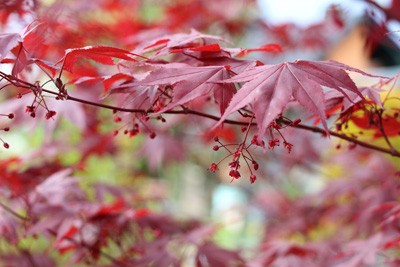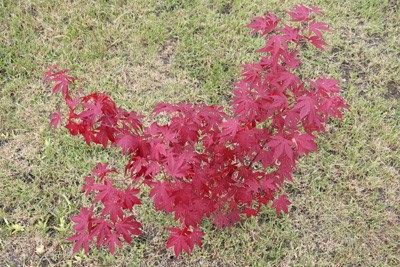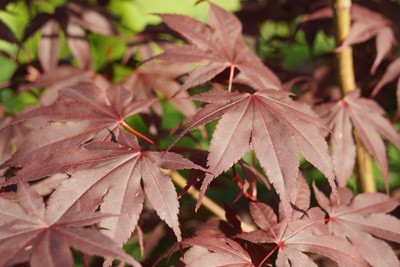Japanese maple (Acer japonicum) is a small tree or shrub, which, as the name suggests, originates from Japan. It can grow up to 10 meters high. The autumn coloration is striking. The leaves then change colors, becoming bright yellow, orange and red. But also the flowers are not without. Although they are not large, but they still stand out. They are umbels (10 to 15 flowers, long stemmed). The flowers have purple sepals and pink petals.
Two other features distinguish the Japanese maple, special leaf and a very unique growth habit. The plants are well suited as solitary, so they achieve the best effect. Many varieties are also ideal for keeping in planters. In typical Japanese gardens, one usually finds several Japanese maple trees. This also gives a harmonious picture.
Many suppliers combine the special Japanese maples (Acer japonicum) and the fan maples ( Acer palmatum) into one species. Sometimes the golden maple (Acer shirasawanum ‘Aureum’) is added. There are about 400 to 500 varieties. All are striking for their foliage, growth habit and many for spectacular fall color. The colorful little trees are particularly effective against a green background, i.e. a hedge. All Japanese maples can be underplanted quite well. The root system is rather loosely branched and has a small amount of fine roots.
Contents
Especially beautiful varieties for the home garden
- Cristatum – curled leaves, bizarre growth, narrow, upright, great fall color in strong orange, also suitable for plant trough, grows about 15 cm a year
- Orangeola – orange-red leaf shoots, brown-red in summer, bright orange-red in autumn, broad spreading growth, fountain-like hanging branches, solitary, can be planted in tubs, grows about 10 cm a year, but becomes wide, about 150 to 200 cm
- Osakazuki – dark green, red-brown edged leaves, great fall color in bright red, upright growth, needs a lot of space, grows about 13 cm per year
- Bloodgood – deep red leaf shoots, later dark reddish brown, no special fall color, needs much space to the side, solitary, grows 20 cm a year
- Englishtown – purple foliage color, no special fall coloration, grows wide and funnel shaped, weak grower but grows wider than tall, good for containers
- Nicholsonii – cinnamon red leaves, intense green in summer, distinctive growth, funnel shaped, grows about 13 cm a year
- Oridono nishiki – great foliage – irregular creamy white, flamingo pink and frog green, bark is also variegated, fall color yellow orange to purple red, fast growing, tightly upright, grows about 22 cm a year, good as specimen or in containers
- Sango kaku – leaves green, young twigs coral red, autumn color golden yellow, tight upright growth, grows about 18 cm a year, beautiful contrasts

Japanese maple – care
The Japanese maple is quite easy to care for. Important for good growth and a healthy tree are the appropriate location, soil preparation at planting and proper watering. Other than that, there is not much to do. Pruning is limited to cutting out diseased or dead shoots. Fertilizing is also done only once a year. Most of the maples are sufficiently hardy. Only potted specimens need some protection. Overall, a wonderful garden shrub that does not take much time.
Location, substrate and planting are largely responsible for the great foliage color. Only when the plant is comfortable will it produce the great colors.
Location
The location is of utmost importance. The individual varieties have quite different wishes. These should be known and fulfilled, otherwise you will not have much joy with your Japanese maple.
- Sunny to light-shaded location
- Many varieties tolerate bright sun, really need it to form the beautiful colors.
- However, some of the maple plants do not tolerate sun well. So when buying, pay attention to the variety name and then be sure to look up what the location should be.
- In the first few years, the leaves may burn, but this will give in time.
- Recommended for all is a place protected from the wind, so that the leaves do not tatter.
- Also, a drafty location is often responsible for burned leaf tips (leaf tip drought).
- Proximity to a pond or water brings higher humidity, helps the little trees feel more comfortable.
Planting substrate

Substrate, too, should accommodate the woody plants. The soil must be loose and very permeable. Although many of the maples like slightly moist soil, waterlogging is poison for them.
- Freshly moist, acidic to neutral, nutrient-rich, sandy to loamy-humic soil.
- Heavy clay soils need to be mixed with sand or peat.
- Normal garden soils do well with a sub-mixture of rotted leaf compost.
- Drainage in the bottom of the pot is important when growing in tubs.
- Waterlogging is not tolerated!
- Burns on the leaves can be avoided by a higher humidity. Therefore, a layer of mulch over the soil is recommended.
- For potted plants also use the potted plant substrate.

Plants
Planting a Japanese maple is not difficult. You need to dig a sufficiently large planting hole, well loosen the soil and prepare the substrate accordingly. When planting in a container, a sufficiently large vessel is required. It is important to have drainage in the container.
Since maple trees do not like wet feet, it is ideal to plant them on a small hill. This allows excess water to drain away well.
Never plant a Japanese maple in a place where one with Verticillium wilt has previously stood. No excavation and exchange will help!
Before planting, loosen the soil extensively, at least 30 cm deep, better 50 cm. This improves air circulation.
Watering and fertilizing
In contrast to the normal maple, the Japanese maple is a shallow rooter. This means that a lot of water is evaporated. Older specimens cope quite well with lack of water, but young and freshly planted specimens do not.
- In summer, Japanese maple needs plenty of water.
- It is best to water in the morning or evening, or both if it is very hot.
- Do not water over the leaves, this will cause burning.
- Fertilize in the spring. It is best to use depot fertilizer, then this single dose will be enough for the whole year.
- In the fall, you can fertilize with patent potash, which will ensure that the maples better survive the winter.
- In the tub, a different fertilization is required. It is best to use coated slow-release fertilizer. 1 g/l substrate should be enough.
Cutting
Pruning would change the characteristic growth habit and that would be a real shame. In most cases, it is not necessary to cut. However, when planting, it is important to consider how big the maple will grow and have enough space for it.
- Prune infrequently and only to remove dead or diseased branches and shoots.
- Only in the case of strong-growing varieties, it is advisable to slightly shorten the tips of shoots above a bud in June or July.
- After winter, frostbitten shoot tips must also be removed.
- Winter pruning is strongly discouraged, because the interfaces do not heal. Fungal spores can invade there.

Wintering
Most commercially available Japanese maples are sufficiently hardy. Only very cold easterly winds are dangerous. These can already cause damage. That is why a wind-protected location is so important.
For most Japanese maples no winter protection is necessary. Only planters should be somewhat wrapped and placed on Styrofoam or wooden slats.
It is important that the shoots of the tree mature well. Therefore, after the end of July, in any case, do not fertilize nitrogen.
It is important to protect the plant from late frost, when the leaves are already on or off. Covering with fleece helps against this.
When keeping in tubs, water drainage in winter is especially important. The containers should also be placed in a protected location. It is important to place them away from the wind.
Multiply
Japanese maple can be propagated by cuttings, although, of course, the specialty nurseries do not like.
- Cut soft, not yet woody or at least slightly woody cuttings and put them in lava granules (grain size 1mm). Reduce the number of leaves to prevent evaporation through the leaves. Two to three leaflets are sufficient. Cut off the tip of the shoot.
- So-called jiffy pots are suitable as containers.
- It is often useful to use a rooting hormone.
- ne warm and humid environment promotes rooting.
- Place in a bright position, but no sun.
- Keep the substrate moist, but not wet.
- Do not forget to ventilate.
- It takes about 8 weeks for small roots to form.
- The best time to propagate cuttings is late May to late June.
- Actually, it is quite easy.

Diseases and pests
Japanese maple is threatened by Verticillium wilt, a fungal disease. The pathogens are found in the soil and enter the entire tree through the roots. The result is droopy leaves and dead branches. Usually, the woody plant cannot be saved. There is no fungicide to combat the fungus. Even pruning does not bring any help. One can only prevent it. That is why the right location is so important. Also, the soil must be well prepared.
Total failures can sometimes be prevented by generously cutting out diseased branches. It is essential to ensure clean cutting tools, preferably disinfected.
Otherwise, the trees are quite healthy and are not greatly affected by pests.
Conclusion
The Japanese maple is a dream when it shows its colors and its special growth. There are varieties that are quite sensitive not to say quite mimosas, but many are healthy and less demanding. A Japanese maple is at the top of my wish list, but for this garden now they are unsuitable. It’s way too windy where we live. I always say we live in a wind tunnel. But it’s penciled in, although I don’t know yet which variety I would choose. Maybe it will be two.
In any case, such a little tree is a real eye-catcher. It also does not need much care. Ideal is the culture in a planter. Then you can take him in the summer something from the midday sun, which is often not so well tolerated and in the winter very protected place. I think these woody plants are just great.










